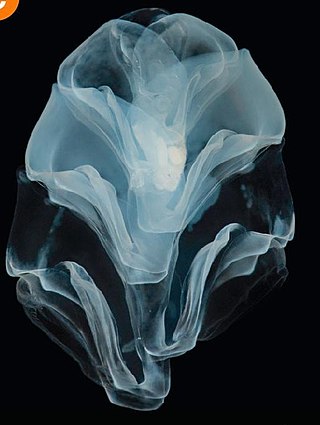Genus is a taxonomic rank used in the biological classification of living and fossil organisms as well as viruses. In the hierarchy of biological classification, genus comes above species and below family. In binomial nomenclature, the genus name forms the first part of the binomial species name for each species within the genus.

In taxonomy, binomial nomenclature, also called binary nomenclature, is a formal system of naming species of living things by giving each a name composed of two parts, both of which use Latin grammatical forms, although they can be based on words from other languages. Such a name is called a binomial name, a binomen, binominal name, or a scientific name; more informally it is also historically called a Latin name. In the ICZN, the system is also called binominal nomenclature, "binomi'N'al" with an "N" before the "al", which is not a typographic error, meaning "two-name naming system".

Extinction is the termination of a taxon by the death of its last member. A taxon may become functionally extinct before the death of its last member if it loses the capacity to reproduce and recover. Because a species' potential range may be very large, determining this moment is difficult, and is usually done retrospectively. This difficulty leads to phenomena such as Lazarus taxa, where a species presumed extinct abruptly "reappears" after a period of apparent absence.

The International Union for Conservation of Nature (IUCN) Red List of Threatened Species, also known as the IUCN Red List or Red Data Book, founded in 1964, is an inventory of the global conservation status and extinction risk of biological species. A series of Regional Red Lists, which assess the risk of extinction to species within a political management unit, are also produced by countries and organizations.

A cockle is an edible marine bivalve mollusc. Although many small edible bivalves are loosely called cockles, true cockles are species in the family Cardiidae.

Ostrea is a genus of edible oysters, marine bivalve mollusks in the family Ostreidae, the oysters.

The maxima clam, also known as the small giant clam, is a species of bivalve mollusc found throughout the Indo-Pacific region.

Hippopus hippopus, also known as the Horse Hoof clam and Strawberry clam, is a species of giant clam in the Subfamily Tridacninae and the genus Hippopus. Hippopus is a delicacy in many Southeast Asian countries due to its high quality meat.

Hippopus is a genus of large tropical saltwater clams, marine bivalve molluscs in the subfamily Tridacninae, the giant clam subfamily, of the family Cardiidae.
A species (pl. species) is often defined as the largest group of organisms in which any two individuals of the appropriate sexes or mating types can produce fertile offspring, typically by sexual reproduction. It is the basic unit of classification and a taxonomic rank of an organism, as well as a unit of biodiversity. Other ways of defining species include their karyotype, DNA sequence, morphology, behaviour, or ecological niche. In addition, paleontologists use the concept of the chronospecies since fossil reproduction cannot be examined.
Central place foraging (CPF) theory is an evolutionary ecology model for analyzing how an organism can maximize foraging rates while traveling through a patch, but maintains the key distinction of a forager traveling from a home base to a distant foraging location rather than simply passing through an area or travelling at random. CPF was initially developed to explain how red-winged blackbirds might maximize energy returns when traveling to and from a nest. The model has been further refined and used by anthropologists studying human behavioral ecology and archaeology.

Calycophorae is a suborder of Siphonophores alongside two other suborders Physonectae and Cystonectae. This suborder includes the giant siphonophore, ; one of the longest lengthwise extant creatures (40–50m). While the Physonectae have a pneumatophore, nectophore, and a siphosome, Cystonectae lack a nectophore, and Calycophorae lack a pneumatophore. From the bell-shaped nectophores, Physonectae and Calycophorae are called Codonophores or Greek for bell-bearers. The distribution, morphology, and behaviors of Calycophorae species are vast and greatly depend on the species. Calycophoraes typically consist of two nectophores with a siphosome that have many tentacles that grow out of the siphosome. The Calycophoraes move by propelling water out of the nectophore much like how jellyfishes move. The tentacles act as fishing nets where the nematocysts on the tentacles paralyze their prey which are then later fed on. Calycophorae have three life stages, which are the larval development stage, the polygastric stage, and the eudoxid maturation stage. Each Calycophorae colony forms from one fertilized egg.

The Coral reefs of the Solomon Islands consists of six major islands and over 986 smaller islands, in Oceania, to the east of Papua New Guinea and northwest of Vanuatu. The Solomon Islands lie between latitudes 5° and 13°S, and longitudes 155° and 169°E. The distance between the westernmost and easternmost islands is about 1,500 km (930 mi). The Santa Cruz Islands are situated north of Vanuatu and are especially isolated at more than 200 km (120 mi) from the other islands. The Solomon Islands has the 22nd largest Exclusive Economic Zone of 1,589,477 km2 (613,701 sq mi) of the Pacific Ocean.

Hippopodius is a genus of cnidarians belonging to the family Hippopodiidae.

Hippopodiidae is a family of cnidarians belonging to the order Siphonophorae.
Hippoporella is a genus of bryozoans belonging to the family Hippoporidridae.

Mudjekeewis Dalisay Santos is a Filipino fisheries scientist and marine biologist at the National Fisheries Research and Development Institute (NFRDI). He was the first Career Scientist to have been conferred the Scientist V rank by the Scientific Career System. In July 2018, he was elected and conferred as an academician member of the National Academy of Science and Technology of the Philippines (NAST-PHL). He is also the president of the Philippine Society in Biochemistry and Molecular Biology since 2022. His fields of interest in fisheries science are genetics, resource assessment, aquatic biodiversity, biotechnology, climate change adaptation, and policy.












